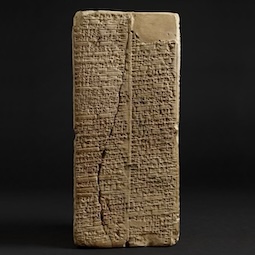Tell Uhaimir (west Kish, ancient Kish)
The city of Kish was a leader of cities in ancient Iraq. It was especially powerful politically during the third millennium BC. In this period, Kish was the only city in the north to be as important as other major centres in the south, such as Uruk, Larsa, Ur, Eridu, and Nippur. Although Kish's importance seems to have faded during the Old Babylonian period (2004-1595 BC), it prospered again from the first millennium BC until the Sasanian period (224-651 AD).
 [/kish/images/skl-large.jpg]
[/kish/images/skl-large.jpg]The most complete manuscript of the Sumerian King List ("Weld-Blundell Prism", AN1923.444 [https://www.ashmolean.org/sumerian-king-list]) Source: Ashmolean Museum, University of Oxford
One of the reasons why Kish was so important is preserved in a cuneiform text now known as the Sumerian King List [https://etcsl.orinst.ox.ac.uk/section2/tr211.htm], which tells us that Kish was the city of kings. This literary work recounts that "after the great flood" which destroyed the world in the very distant past, kingship was first re-established at Kish. The title "King of Kish" was therefore very prestigious, even for kings who may not have ruled this city originally (Frayne 2008: 67).
We do not know how large Kish was in ancient times, but a few clues remain about its layout. For example, cuneiform tablets from the second and first millennium BC tell us that there used to be a wall around the city. King Samsu-iluna commissioned it to protect Kish during his 24th year of rule [https://cdli-gh.github.io/year-names/GLOSSAR/T12K07Y36.htm]. He called it in Sumerian the Melem-kurkurra-dulla, the "wall whose aura covers the lands" (George 1993: no. 51).
Kish was also a port city, built close to the Euphrates, with its twin city Hursagkalama (on Tell Ingharra) set on the other side of the river to the east. This connection to water enabled Kish to prosper, thanks to easy access to transportation and trade. It also connected the city to other people and locations. In the Old Babylonian period, for example, we know that Kish was linked to the city of Marad via a canal called in Akkadian the Me-Enlil, "Water of Enlil" (Dalley 2023: 37). There is also evidence that a thousand years later, a canal also linked Kish to Sippar (Dalley 2023 45).
Kish and Hursagkalama were also connected to Babylon. A canal called the Banitu linked all three cities (Dalley 2023: 36, 44). A cuneiform text purchased by the British Museum in 1886 tells us that a palm festival celebrated during the reign of king Darius I, in the year 509 BC, in the month Kislimu (that is, in November or December) included taking the statues of three goddesses from Babylon to visit Kish and Hursagkalama (BM 78076 [https://www.britishmuseum.org/collection/object/W_1886-0512-1]). Accompanied by musicians, the statues travelled to Kish by boat where they visited the god Zababa in his temple. After staying the night, they then went to visit Ishtar/Ninlil in her temple at Hursagkalama. When rituals were over in both cities, which included celebratory meals, the statues were returned to Babylon via Kish (George 2000: 280-289, no. 4 [https://www.ebl.lmu.de/library/BM.78076]).
We do not know the names of all the canals at Kish, but several are preserved in cuneiform texts, for example the canal of the goddess Bizilla who assisted the goddess Ishtar at Hursagkalama (Dalley 2023: 33).
The following mounds are all part of Tell Uhaimir today:
- The ziggurat of Zababa (Mound Z)
- The Town Site, or House Ruins (Mound T)
- The Fortress (Mound X)
- Tell Khazna
30 Oct 2025
Nadia Aït Saïd-Ghanem
Nadia Aït Saïd-Ghanem, 'Tell Uhaimir (west Kish, ancient Kish)', The Forgotten City of Kish • مدينة كيش المنسية, The Kish Project, 2025 [http://oracc.org/MoundsofKish/TellUhaimir/]